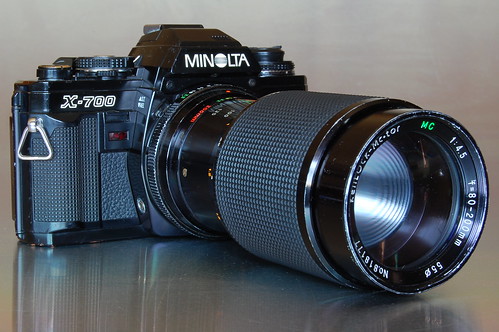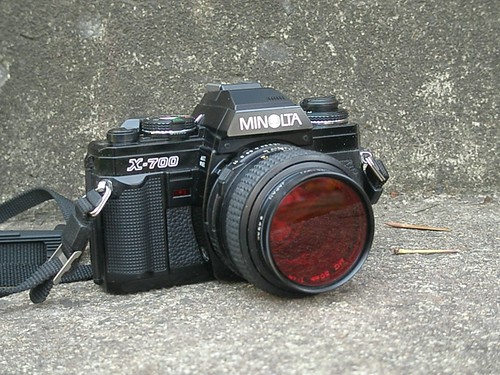Difference between revisions of "Minolta X-700"
m |
Mwerneburg (talk | contribs) (extensive revision correcting some facts and expanding the description) |
||
| Line 2: | Line 2: | ||
|image_source= http://www.flickr.com/photos/raulm/4747241468/in/pool-camerapedia | |image_source= http://www.flickr.com/photos/raulm/4747241468/in/pool-camerapedia | ||
|image= http://farm5.static.flickr.com/4143/4747241468_7f02a2cfd5.jpg | |image= http://farm5.static.flickr.com/4143/4747241468_7f02a2cfd5.jpg | ||
| − | |image_align= | + | |image_align= center |
|image_text= image by Raúl Sá Dantas | |image_text= image by Raúl Sá Dantas | ||
}} | }} | ||
| Line 8: | Line 8: | ||
|image_source= http://www.flickr.com/photos/angelakleis/2040118161/in/pool-camerapedia/ | |image_source= http://www.flickr.com/photos/angelakleis/2040118161/in/pool-camerapedia/ | ||
|image= http://farm3.static.flickr.com/2364/2040118161_fd4201cb39.jpg | |image= http://farm3.static.flickr.com/2364/2040118161_fd4201cb39.jpg | ||
| − | |image_align= | + | |image_align= center |
|image_text= image by Angela Kleis | |image_text= image by Angela Kleis | ||
}} | }} | ||
{{br}} | {{br}} | ||
| − | First manufactured in | + | First manufactured in 1981, the Minolta '''X-700''' was a [[single lens reflex]] camera. It featured manual, aperture priority and programmed automatic exposure modes when used with MD lenses. MC lens could be used in aperture priority and manual modes. An immediate commercial success for Minolta, it was awarded the EISA "Camera of the Year" award in 1981 and was continually produced until 1999, well into the auto-focus era. The camera was the last Minolta manual focus camera body produced. |
| + | As a mid-range consumer-grade camera, its feature set included a program mode but not the visibility of the selected shutter speed through the viewfinder. Similarly, the body was made with a metal frame but was encased in plastic. The shutter was a horizontally-traveling cloth shutter with a top speed of 1/1000 sec and a flash sync speed of 1/60s. | ||
| − | + | Despite having these relatively slow shutter figures, the camera does support TTL flash metering. In program mode and using a TTL flash designed for the X series, automatic exposure including the flash and aperture/shutter-speed is possible. Such TTL flash support is not something you're guaranteed to find in modern DSLR cameras. | |
| − | |||
| − | |||
| − | |||
| + | Compensating for its humble internal feature set, the X-700 was the center of a 'system' of external accessories. Auto-winders, external grips, a set of flashes, extensions tubes and bellow for macro work, an IR remote-control, and two multi-function backs. | ||
| + | Today the X-700 is easy to find on the used market at low cost; the MC and MD lenses that it supports are similarly plentiful and inexpensive (with some pricey exceptions). With a low cost, bright viewfinder, its program mode, and automated flash exposure, this is a versatile camera that can serve a new-comer well in exploring film photography. | ||
== Links == | == Links == | ||
| Line 29: | Line 29: | ||
* [http://www.collection-appareils.fr/album_notices_K_O/Minolta_X700_UM/index.html English User Manual], [http://www.collection-appareils.fr/album_notices_K_O/Minolta_x_700/index.html French User Manual] on [http://www.collection-appareils.fr/general/html/francais.php www.collection-appareils.fr] by Sylvain Halgand | * [http://www.collection-appareils.fr/album_notices_K_O/Minolta_X700_UM/index.html English User Manual], [http://www.collection-appareils.fr/album_notices_K_O/Minolta_x_700/index.html French User Manual] on [http://www.collection-appareils.fr/general/html/francais.php www.collection-appareils.fr] by Sylvain Halgand | ||
* [http://www.thecamerasite.net/01_SLR_Cameras/Pages/minoltax.htm Minolta X-700] at [http://www.thecamerasite.net The Camera Site] by Reijo Lauro | * [http://www.thecamerasite.net/01_SLR_Cameras/Pages/minoltax.htm Minolta X-700] at [http://www.thecamerasite.net The Camera Site] by Reijo Lauro | ||
| + | * [http://emuu.net/review:-Minolta-X-700-camera review: Minolta X-700] by Michael Werneburg | ||
[[Category: Japanese 35mm SLR]] | [[Category: Japanese 35mm SLR]] | ||
Revision as of 11:47, 2 May 2011

|
| image by Raúl Sá Dantas |

|
| image by Angela Kleis |
First manufactured in 1981, the Minolta X-700 was a single lens reflex camera. It featured manual, aperture priority and programmed automatic exposure modes when used with MD lenses. MC lens could be used in aperture priority and manual modes. An immediate commercial success for Minolta, it was awarded the EISA "Camera of the Year" award in 1981 and was continually produced until 1999, well into the auto-focus era. The camera was the last Minolta manual focus camera body produced.
As a mid-range consumer-grade camera, its feature set included a program mode but not the visibility of the selected shutter speed through the viewfinder. Similarly, the body was made with a metal frame but was encased in plastic. The shutter was a horizontally-traveling cloth shutter with a top speed of 1/1000 sec and a flash sync speed of 1/60s.
Despite having these relatively slow shutter figures, the camera does support TTL flash metering. In program mode and using a TTL flash designed for the X series, automatic exposure including the flash and aperture/shutter-speed is possible. Such TTL flash support is not something you're guaranteed to find in modern DSLR cameras.
Compensating for its humble internal feature set, the X-700 was the center of a 'system' of external accessories. Auto-winders, external grips, a set of flashes, extensions tubes and bellow for macro work, an IR remote-control, and two multi-function backs.
Today the X-700 is easy to find on the used market at low cost; the MC and MD lenses that it supports are similarly plentiful and inexpensive (with some pricey exceptions). With a low cost, bright viewfinder, its program mode, and automated flash exposure, this is a versatile camera that can serve a new-comer well in exploring film photography.
Links
- Review at Modern Classics
- image at ukcamera
- X700 on www.collection-appareils.fr by Sylvain Halgand
- English User Manual, French User Manual on www.collection-appareils.fr by Sylvain Halgand
- Minolta X-700 at The Camera Site by Reijo Lauro
- review: Minolta X-700 by Michael Werneburg